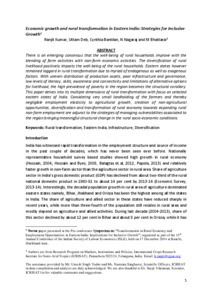Economic growth and rural transformation in Eastern India: Strategies for Inclusive Growth
Abstract
There is an emerging consensus that the well-being of rural households improve with the blending of farm activities with non-farm economic activities. The diversification of rural livelihood positively impacts the well-being of the rural households. Eastern states however remained laggard in rural transformation due to myriad of endogenous as well as exogenous factors. With uneven distribution of production assets, poor infrastructure and governance, low levels of literacy, skills, awareness and connectivity and limitations of alternative options for livelihood, the high prevalence of poverty in the region becomes the structural corollary. This paper delves into its multiple dimensions of rural transformation with focus on selected eastern states of India. Considering very small landholding of the farmers and thereby negligible employment elasticity to agricultural growth, creation of non-agricultural opportunities, diversification and transformation of rural economy towards expanding rural non-farm employment are adjunct to the strategies of managing vulnerabilities associated to the region bringing meaningful structural change in the rural socio-economic conditions

